Valley-Dependent Electronic Properties of Metal Monochalcogenides GaX and Janus Ga2XY (X, Y = S, Se, and Te)
Abstract
:1. Introduction
2. Calculation Methods
3. Results and Discussion
4. Conclusions
Author Contributions
Funding
Data Availability Statement
Conflicts of Interest
References
- Manzeli, S.; Ovchinnikov, D.; Pasquier, D.; Yazyev, O.V.; Kis, A. 2D transition metal dichalcogenides. Nat. Rev. Mater. 2017, 2, 17033. [Google Scholar] [CrossRef]
- Das, S.; Robinson, J.A.; Dubey, M.; Terrones, H.; Terrones, M. Beyond Graphene: Progress in Novel Two-Dimensional Materials and van der Waals Solids. Annu. Rev. Mater. Res. 2015, 45, 1–27. [Google Scholar] [CrossRef]
- Chaves, A.; Azadani, J.G.; Alsalman, H.; da Costa, D.R.; Frisenda, R.; Chaves, A.J.; Song, S.H.; Kim, Y.D.; He, D.; Zhou, J.; et al. Bandgap engineering of two-dimensional semiconductor materials. NPJ 2D Mater. Appl. 2020, 4, 29. [Google Scholar] [CrossRef]
- Akinwande, D.; Brennan, C.J.; Bunch, J.S.; Egberts, P.; Felts, J.R.; Gao, H.; Huang, R.; Kim, J.S.; Li, T.; Li, Y.; et al. A review on mechanics and mechanical properties of 2D materials-Graphene and beyond. Extreme Mech. Lett. 2017, 13, 42–77. [Google Scholar] [CrossRef]
- Lin, Z.; McCreary, A.; Briggs, N.; Subramanian, S.; Zhang, K.; Sun, Y.; Li, X.; Borys, N.J.; Yuan, H.; Fullerton-Shirey, S.K.; et al. 2D materials advances: From large scale synthesis and controlled heterostructures to improved characterization techniques, defects and applications. 2D Mater. 2016, 3, 042001. [Google Scholar] [CrossRef]
- Choi, H.; Min, K.A.; Cha, J.; Hong, S. Mixed-dimensional 2D/3D heterojunctions between MoS2 and Si(100). Phys. Chem. Chem. Phys. 2018, 20, 25240–25245. [Google Scholar] [CrossRef] [PubMed]
- Kim, J.; Min, K.A.; Cha, J.; Hong, S. Contact properties of 2D/3D GaSe/Si(1 1 1) heterostructure. Appl. Surf. Sci. 2020, 516, 145969. [Google Scholar] [CrossRef]
- Kim, J.; Choi, C.G.; Min, K.A.; Cho, K.; Hong, S. Effect of atomic passivation at Ni-MoS2 interfaces on contact behaviors. Curr. Appl. Phys. 2020, 20, 132–136. [Google Scholar] [CrossRef]
- Min, K.A.; Hong, S. Doping effect in graphene on oxide substrates: MgO(111) andSiO2(0001). Curr. Appl. Phys. 2015, 15, S103–S107. [Google Scholar] [CrossRef]
- Sung, D.; Min, K.A.; Hong, S. Investigation of atomic and electronic properties of 2D-MoS2/3D-GaN mixed dimensional heterostructures. Nanotechnology 2019, 30, 404002. [Google Scholar] [CrossRef]
- Jaffery, S.H.A.; Kim, J.; Dastgeer, G.; Hussain, M.; Ali, A.; Hussain, S.; Eom, J.; Hong, S.; Jung, J. Thickness-Dependent, Gate-Tunable Rectification and Highly Sensitive Photovoltaic Behavior of Heterostructured GeSe/WS2 p–n Diode. Adv. Mater. Interfaces 2020, 7, 2000893. [Google Scholar] [CrossRef]
- Lee, C.H.; Lee, G.H.; Zande, A.M.V.D.; Chen, W.; Li, Y.; Han, M.; Cui, X.; Arefe, G.; Nuckolls, C.; Heinz, T.F.; et al. Atomically thin p–n junctions with van der Waals heterointerfaces. Nat. Nanotechnol. 2014, 9, 676–681. [Google Scholar] [CrossRef] [PubMed]
- Frisenda, R.; Molina-Mendoza, A.J.; Mueller, T.; Castellanos-Gomez, A.; Zant, H.S.J.V.D. Atomically thin p–n junctions based on two-dimensional materials. Chem. Soc. Rev. 2018, 47, 3339. [Google Scholar] [CrossRef] [PubMed]
- Pesci, F.M.; Sokolikova, M.S.; Grotta, C.; Sherrell, P.C.; Reale, F.; Sharda, K.; Ni, N.; Palczynski, P.; Mattevi, C. MoS2/WS2 Heterojunction for Photoelectrochemical Water Oxidation. J. Am. Chem. Soc. 2017, 7, 4990–4998. [Google Scholar] [CrossRef]
- Nazir, G.; Kim, H.; Kim, J.; Kim, K.S.; Shin, D.H.; Khan, M.F.; Lee, D.S.; Hwang, J.Y.; Hwang, C.; Suh, J.; et al. Ultimate limit in size and performance of WSe2 vertical diodes. Nat. Commun. 2018, 9, 5371. [Google Scholar] [CrossRef] [PubMed]
- Kim, J.; Choi, J.; Kang, Y. First-principles study of SrTe and BaTe: Promising wide-band-gap semiconductors with ambipolar doping. Curr. Appl. Phys. 2023, 48, 90–96. [Google Scholar] [CrossRef]
- Lee, T.; Lee, K.-Y.; Lee, Y.-J.; Cho, C.-H.; Rho, H. Suppression of substrate-induced charge doping in hBN-encapsulated monolayer WS2. Curr. Appl. Phys. 2023, 49, 115–119. [Google Scholar] [CrossRef]
- Tao, W.-L.; Lan, J.-Q.; Hu, C.-E.; Cheng, Y.; Zhu, J. Hua-Yun Geng; Thermoelectric properties of Janus MXY (M = Pd, Pt; X, Y = S, Se, Te) transition-metal dichalcogenide monolayers from first principles. J. Appl. Phys. 2020, 127, 035101. [Google Scholar] [CrossRef]
- Rawat, A.; Mohanta, M.K.; Jena, N.; Ahammed, R.; De Sarkar, A. Nanoscale Interfaces of Janus Monolayers of Transition Metal Dichalcogenides for 2D Photovoltaic and Piezoelectric Applications. J. Phys. Chem. C 2020, 124, 10385–10397. [Google Scholar] [CrossRef]
- Ahammed, R.; Jena, N.; Rawat, A.; Mohanta, M.K.; De Sarkar, A. Ultrahigh Out-of-Plane Piezoelectricity Meets Giant Rashba Effect in 2D Janus Monolayers and Bilayers of Group IV Transition-Metal Trichalcogenides. J. Phys. Chem. C 2020, 124, 21250–21260. [Google Scholar] [CrossRef]
- Ju, L.; Bie, M.; Tang, X.; Shang, J.; Kou, L. Janus WSSe Monolayer: An Excellent Photocatalyst for Overall Water Splitting. ACS Appl. Mater. Interfaces 2020, 12, 29335–29343. [Google Scholar] [CrossRef] [PubMed]
- Chen, Y.; Liu, J.; Yu, J.; Guo, Y.; Sun, Q. Symmetry-breaking induced large piezoelectricity in Janus tellurene materials. Phys. Chem. Chem. Phys. 2019, 21, 1207–1216. [Google Scholar] [CrossRef] [PubMed]
- Dimple; Jena, N.; Rawat, A.; Ahammed, R.; Mohanta, M.K.; De Sarkar, A. Emergence of high piezoelectricity along with robust electron mobility in Janus structures in semiconducting Group IVB dichalcogenide monolayers. J. Mater. Chem. A 2018, 6, 24885. [Google Scholar] [CrossRef]
- Peng, R.; Ma, Y.; Huang, B.; Dai, Y. Two-dimensional Janus PtSSe for photocatalytic water splitting under the visible or infrared light. J. Mater. Chem. A 2019, 7, 603. [Google Scholar] [CrossRef]
- Nandi, P.; Rawat, A.; Ahammed, R.; Jena, N.; De Sarkar, A. Group-IV(A) Janus dichalcogenide monolayers and their interfaces straddle gigantic shear and in-plane piezoelectricity. Nanoscale 2021, 13, 5460. [Google Scholar] [CrossRef] [PubMed]
- Manchon, A.; Koo, H.C.; Nitta, J.; Frolov, S.M.; Duine, R.A. New perspectives for Rasha-spin-orbit coupling. Nat. Mater. 2015, 14, 871–882. [Google Scholar] [CrossRef] [PubMed]
- Acosta, C.M.; Fazzio, A.; Dalpian, G.M. Zeeman-type spin splitting in nonmagnetic three-dimensional compounds. NPJ Quantum Mater. 2019, 4, 41. [Google Scholar] [CrossRef]
- Xiao, D.; Yao, W.; Niu, Q. Valley-Contrasting Physics in Graphene: Magnetic Moment and Topological Transport. Phys. Rev. Lett. 2007, 99, 236809. [Google Scholar] [CrossRef] [PubMed]
- Isberg, J.; Gabrysch, M.; Hammersberg, J.; Majdi, S.; Kovi, K.K.; Twitchen, D.J. Generation, transport and detection of valley-polarized electrons in diamond. Nat. Mater. 2013, 12, 760–764. [Google Scholar] [CrossRef]
- Takashina, K.; Ono, Y.; Fujiwara, A.; Takahashi, Y.; Hirayama, Y. Valley Polarization in Si(100) at Zero Magnetic Field. Phys. Rev. Lett. 2006, 96, 236801. [Google Scholar] [CrossRef]
- Shkolnikov, Y.P.; De Poortere, E.P.; Tutuc, E.; Shayegan, M. Valley Splitting of AlAs Two-Dimensional Electrons in a Perpendicular Magnetic Field. Phys. Rev. Lett. 2002, 89, 226805. [Google Scholar] [CrossRef]
- Zhu, Z.; Collaudin, A.; Fauqué, B.; Kang, W.; Behnia, K. Field-induced polarization of Dirac valleys in bismuth. Nat. Phys. 2012, 8, 89–94. [Google Scholar] [CrossRef]
- Mak, K.F.; Xiao, D.; Shan, J. Light-valley interactions in 2D semiconductors. Nat. Photonics 2018, 12, 451–460. [Google Scholar] [CrossRef]
- Zhou, B.T.; Taguchi, K.; Kawaguchi, Y.; Tanaka, Y.; Law, K.T. Spin-orbit coupling induced valley Hall effects in transition-metal dichalcogenides. Commun. Phys. 2019, 2, 26. [Google Scholar] [CrossRef]
- Liu, W.; Luo, C.; Tang, X.; Peng, X.; Zhong, J. Valleytronic properties of monolayer WSe2 in external magnetic field. AIP Adv. 2019, 9, 045222. [Google Scholar] [CrossRef]
- Xiao, D.; Liu, G.B.; Feng, W.; Xu, X.; Yao, W. Coupled Spin and Valley Physics in Monolayers of MoS2 and Other Group-VI Dichalcogenides. Phys. Rev. 2012, 108, 196802. [Google Scholar]
- Xia, J.; Wang, X.; Tay, B.K.; Chen, S.; Liu, Z.; Yan, J.; Shen, Z. Valley polarization in stacked MoS2 induced by circularly polarized light. Nano Res. 2017, 10, 1618–1626. [Google Scholar] [CrossRef]
- Berry, M.V. Quantal Phase Factors Accompanying Adiabatic Changes. Proc. R. Soc. Lond. A 1984, 392, 45–57. [Google Scholar]
- Sodemann, I.; Fu, L. Quantum Nonlinear Hall Effect Induced by Berry Curvature Dipole in Time-Reversal Invariant Materials. Phys. Rev. Lett. 2015, 115, 216806. [Google Scholar] [CrossRef] [PubMed]
- Shin, D.; Sato, S.A.; Hubener, H.; Giovannini, U.D.; Kim, J.; Park, N.; Rubio, A. Unraveling materials Berry curvature and Chern numbers from real-time evolution of Bloch states. Proc. Natl. Acad. Sci. USA 2019, 116, 4135–4140. [Google Scholar] [CrossRef] [PubMed]
- Wang, Y.; Wei, W.; Wang, H.; Mao, N.; Li, F.; Huang, B.; Dai, Y. Janus TiXY Monolayers with Tunable Berry Curvature. J. Phys. Chem. Lett. 2019, 10, 7426–7432. [Google Scholar] [CrossRef] [PubMed]
- Son, J.; Kim, K.H.; Ahn, Y.H.; Lee, H.W.; Lee, J. Strain Engineering of the Berry Curvature Dipole and Valley Magnetization in Monolayer MoS2. Phys. Rev. Lett. 2019, 123, 036806. [Google Scholar] [CrossRef] [PubMed]
- Schaibley, J.R.; Yu, H.; Clark, G.; Rivera, P.; Ross, J.S.; Seyler, K.L.; Yao, W.; Xu, X. Valleytronics in 2D materials. Nat. Rev. Mater. 2016, 1, 16055. [Google Scholar] [CrossRef]
- Liu, M.-Y.; Gong, L.; He, Y.; Cao, C. Tuning Rashba effect, band inversion, and spin-charge conversion of Janus XSn2Y monolayers via an external field. Phys. Rev. B 2021, 103, 075421. [Google Scholar] [CrossRef]
- Zhuang, H.L.; Cooper, V.R.; Xu, H.; Ganesh, P.; Hennig, R.G.; Kent, P.R.C. Rashba effect in single-layer antimony telluroiodide SbTeI. Phys. Rev. B 2015, 92, 115302. [Google Scholar] [CrossRef]
- Liu, Y.; Gao, Y.; Zhang, S.; He, J.; Yu, J.; Liu, Z. Valleytronics in transition metal dichalcogenides materials. Nano Res. 2019, 12, 2695–2711. [Google Scholar] [CrossRef]
- Zhao, S.; Li, X.; Dong, B.; Wang, H.; Wang, H.; Zhang, Y.; Han, Z.; Zhang, H. Valley manipulation in monolayer transition metal dichalcogenides and their hybrid systems: Status and challenges. Rep. Prog. Phys. 2021, 84, 026401. [Google Scholar] [CrossRef]
- Kohn, W.; Sham, L.J. Self-Consistent Equations Including Exchange and Correlation Effects. Phys. Rev. 1965, 140, A1133–A1138. [Google Scholar] [CrossRef]
- Perdew, J.P.; Burke, K.; Ernzerhof, M. Generalized Gradient Approximation Made Simple. Phys. Rev. Lett. 1996, 77, 3865–3868. [Google Scholar] [CrossRef] [PubMed]
- Kresse, G. Efficient iterative schemes for ab initio total-energy calculations using a plane-wave basis set. Phys. Rev. B 1996, 54, 11169–11186. [Google Scholar] [CrossRef]
- Kresse, G.; Furthmiiller, J. Efficiency of ab-initio total energy calculations for metals and semiconductors using a plane-wave basis set. Comput. Mater. Sci. 1996, 6, 15–50. [Google Scholar] [CrossRef]
- Blochl, P.E. Projector augmented-wave method. Phys. Rev. B 1994, 50, 17953–17979. [Google Scholar] [CrossRef]
- Kresse, G.; Jouber, D. From ultrasoft pseudopotentials to the projector augmented-wave method. Phys. Rev. B 1999, 59, 1758–1775. [Google Scholar] [CrossRef]
- Grimme, S.; Antony, J.; Ehrlich, S.; Krieg, H. A consistent and accurate ab initio parametrization of density functional dispersion correction (DFT-D) for the 94 elements H-Pu. J. Chem. Phys. 2010, 132, 154104. [Google Scholar] [CrossRef]
- Xiao, D.; Chang, M.-C.; Niu, Q. Berry phase effects on electronic properties. Rev. Mod. Phys. 2010, 82, 1959. [Google Scholar] [CrossRef]
- Resta, R. Macroscopic polarization in crystalline dielectrics: The geometric phase approach. Rev. Mod. Phys. 1994, 66, 899. [Google Scholar] [CrossRef]
- Nagaosa, N.; Tokura, Y. Topological properties and dynamics of magnetic skyrmions. Nat. Nanotechnol. 2013, 8, 899–911. [Google Scholar] [CrossRef]
- Kim, H.J.; Li, C.; Feng, J.; Cho, J.H.; Zhang, Z. Competing magnetic orderings and tunable topological states in two-dimensional hexagonal organometallic lattices. Phys. Rev. B 2016, 93, 041404. [Google Scholar] [CrossRef]
- Yao, Q.; Cai, J.; Tong, W.; Gong, S.; Wang, J. Manipulation of the large Rashba spin splitting in polar two-dimensional transition-metal dichalcogenides. Phys. Rev. B 2017, 95, 165401. [Google Scholar] [CrossRef]
- Nguyen, H.T.T.; Vi, V.T.T.; Vu, T.V.; Phuc, H.V.; Nguyen, C.V.; Tong, H.D.; Hoa, L.T.; Hieu, N.N. Janus Ga2STe monolayer under strain and electric field: Theoretical prediction of electronic and optical properties. Phys. E 2020, 124, 114358. [Google Scholar] [CrossRef]
- Demirtas, M.; Ozdemir, B.; Mogulkoc, Y.; Durgun, E. Oxygenation of monolayer gallium monochalcogenides: Design of two-dimensional ternary Ga2XO structures (X = S,Se,Te). Phys. Rev. B 2020, 101, 075423. [Google Scholar] [CrossRef]
- Zhong, Q.; Dai, Z.; Liu, J.; Zhao, Y.; Meng, S. Phonon thermal transport in Janus single layer M2XY (M = Ga; X, Y = S, Se, Te): A study based on first-principles. Phys. E Low-Dimens. Syst. Nanostructures 2020, 115, 113683. [Google Scholar] [CrossRef]
- Zhang, J.; Jia, S.; Kholmanov, I.; Dong, L.; Er, D.; Chen, W.; Guo, H.; Jin, Z.; Shenoy, V.B.; Shi, L.; et al. Janus Monolayer Transition-Metal Dichalcogenides. ACS Nano 2017, 11, 8192–8198. [Google Scholar] [CrossRef]
- Lu, A.Y.; Zhu, H.; Xiao, J.; Chuu, C.P.; Han, Y.; Chiu, M.H.; Cheng, C.C.; Yang, C.W.; Wei, K.H.; Yang, Y.; et al. Janus monolayers of transition metal dichalcogenides. Nat. Nanotechnol. 2017, 12, 744–749. [Google Scholar] [PubMed]
- Zólyomi, V.; Drummond, N.D.; Fal’ko, V.I. Band structure and optical transitions in atomic layers of hexagonal gallium chalcogenides. Phys. Rev. B 2013, 87, 195403. [Google Scholar] [CrossRef]
- Aziza, Z.B.; Zólyomi, V.; Henck, H.; Pierucci, D.; Silly, M.G.; Avila, J.; Magorrian, S.J.; Chaste, J.; Chen, C.; Yoon, M.; et al. Valence band inversion and spin-orbit effects in the electronic structure of monolayer GaSe. Phys. Rev. B 2018, 98, 115405. [Google Scholar]
- Li, F.; Wei, W.; Wang, H.; Huang, B.; Dai, Y.; Jacob, T. Intrinsic Electric Field-Induced Properties in Janus MoSSe van der Waals Structures. J. Phys. Chem. Lett. 2019, 10, 559–565. [Google Scholar] [PubMed]
- Szczęśniak, D.; Kais, S. Gap states and valley-spin filtering in transition metal dichalcogenide monolayers. Phys. Rev. B 2020, 101, 115423. [Google Scholar] [CrossRef]
- Ominato, Y.; Fujimoto, J.; Matsuo, M. Valley-Dependent Spin Transport in Monolayer Transition-Metal Dichalcogenides. Phys. Rev. Lett. 2020, 124, 166803. [Google Scholar] [CrossRef]
- Ceferino, A.; Magorrian, S.J.; Zólyomi, V.; Bandurin, D.A.; Geim, A.K.; Patanè, A.; Kovalyuk, Z.D.; Kudrynskyi, Z.R.; Grigorieva, I.V.; Fal’ko, V.I. Tunable spin-orbit coupling in two-dimensional InSe. Phys. Rev. B 2021, 104, 125432. [Google Scholar] [CrossRef]

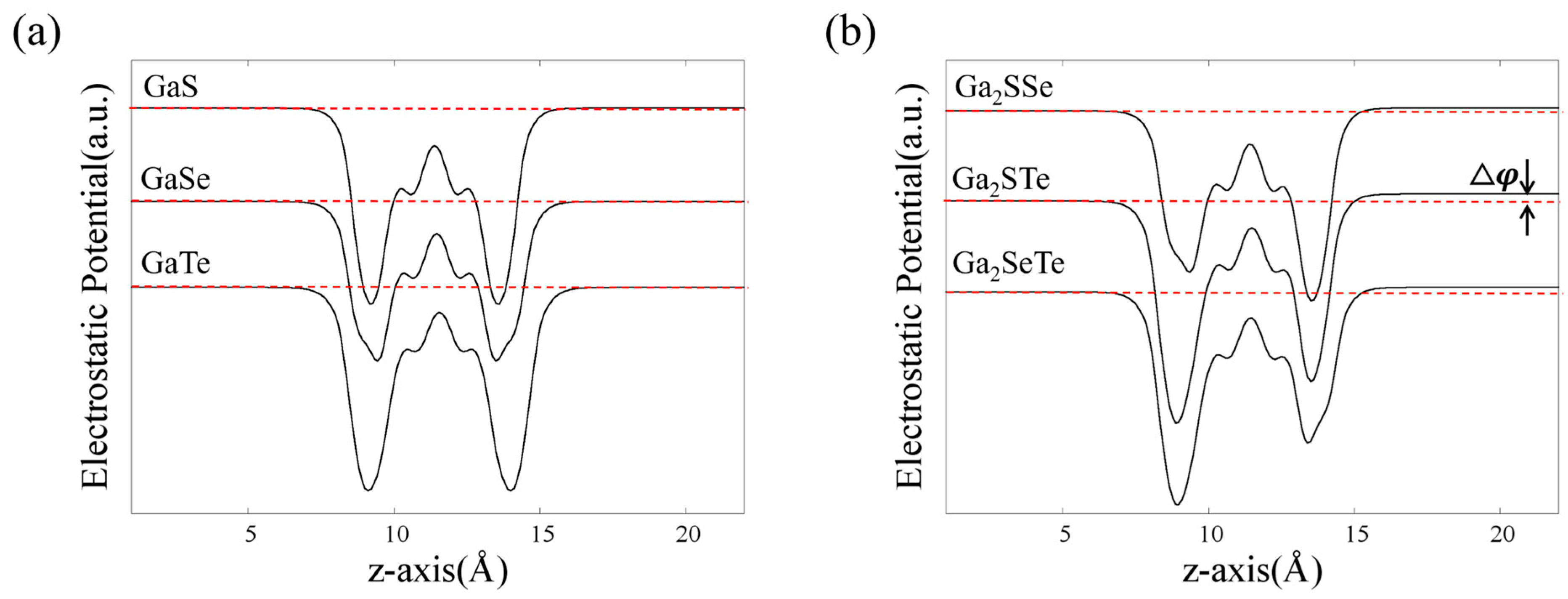
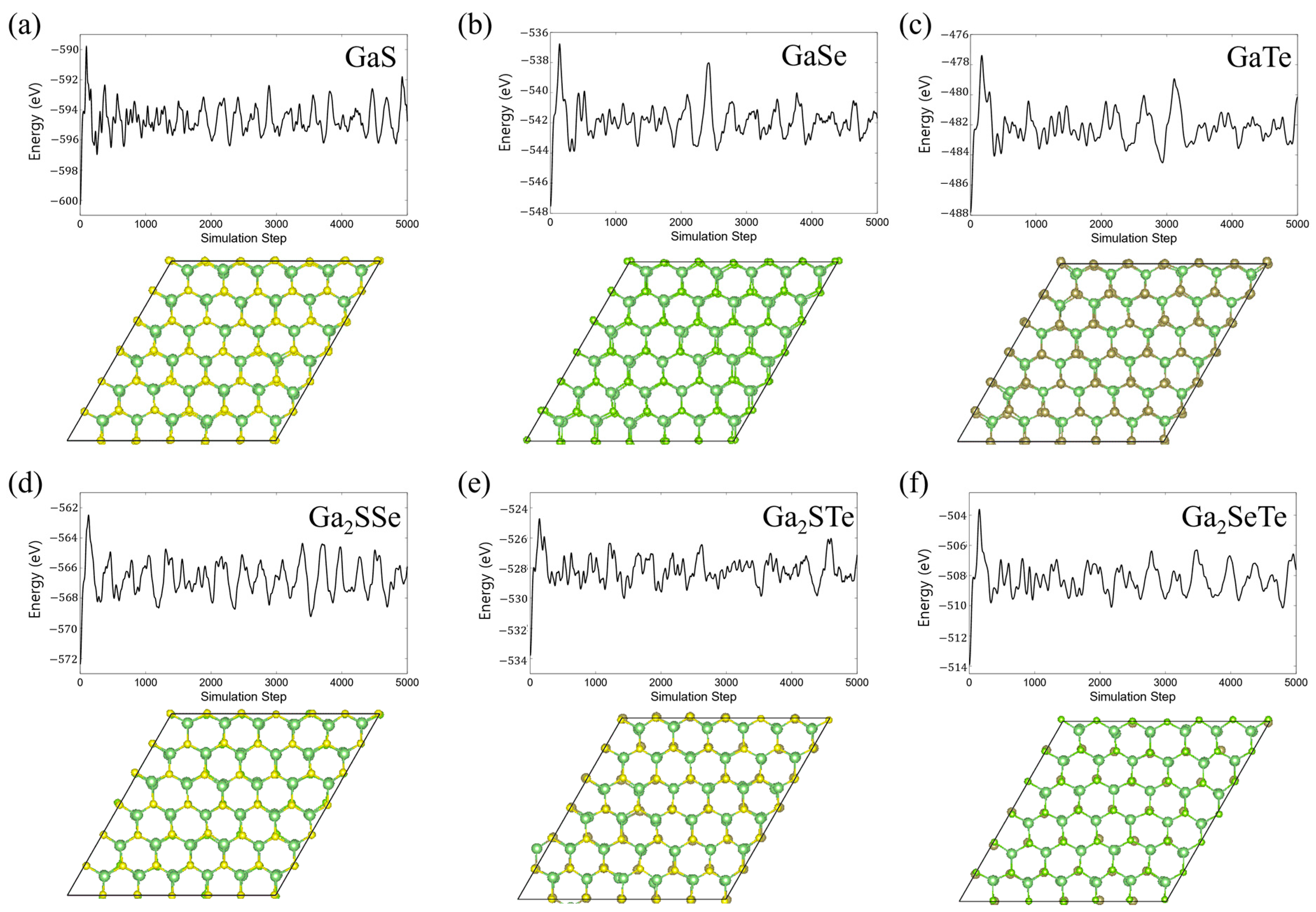
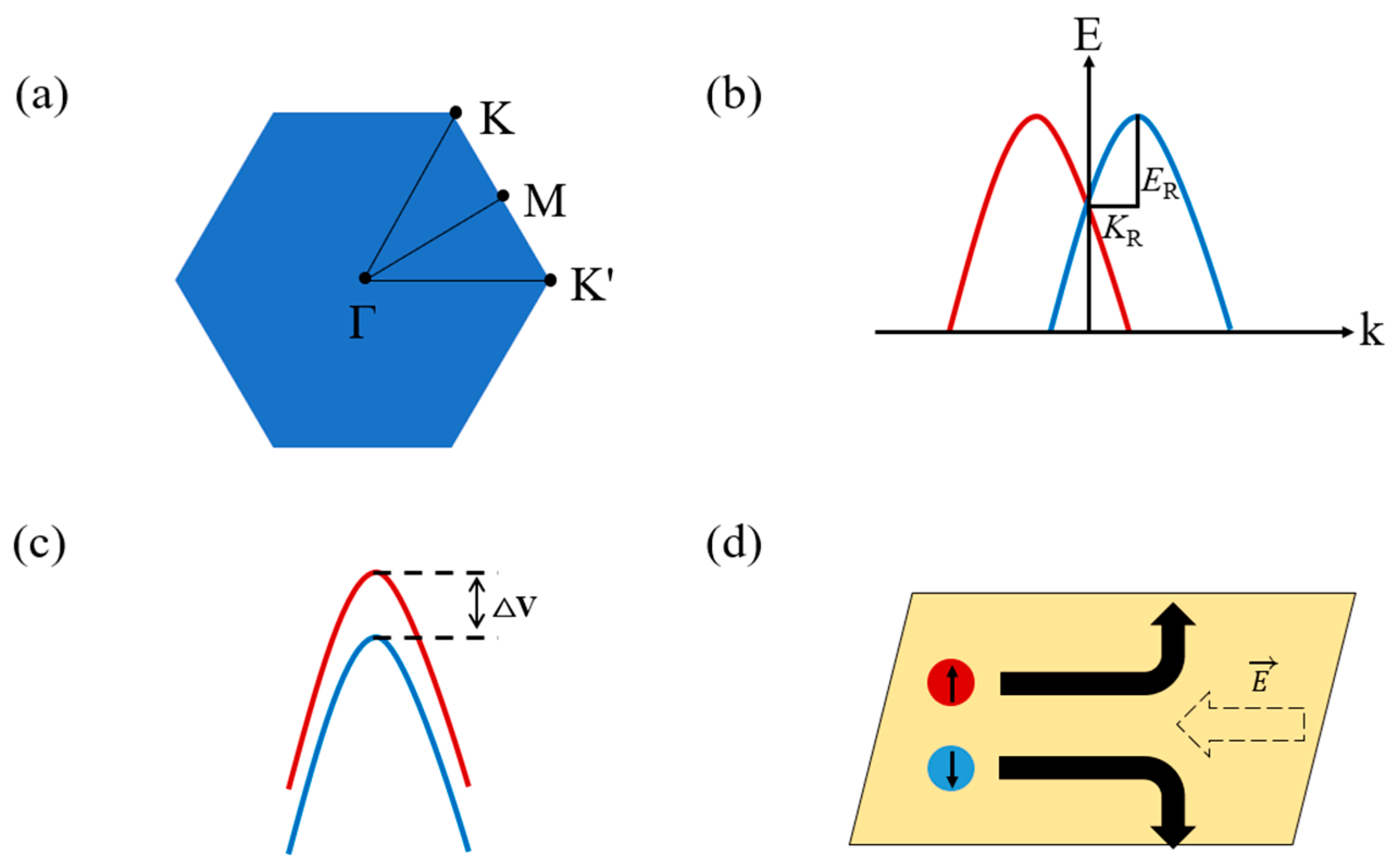
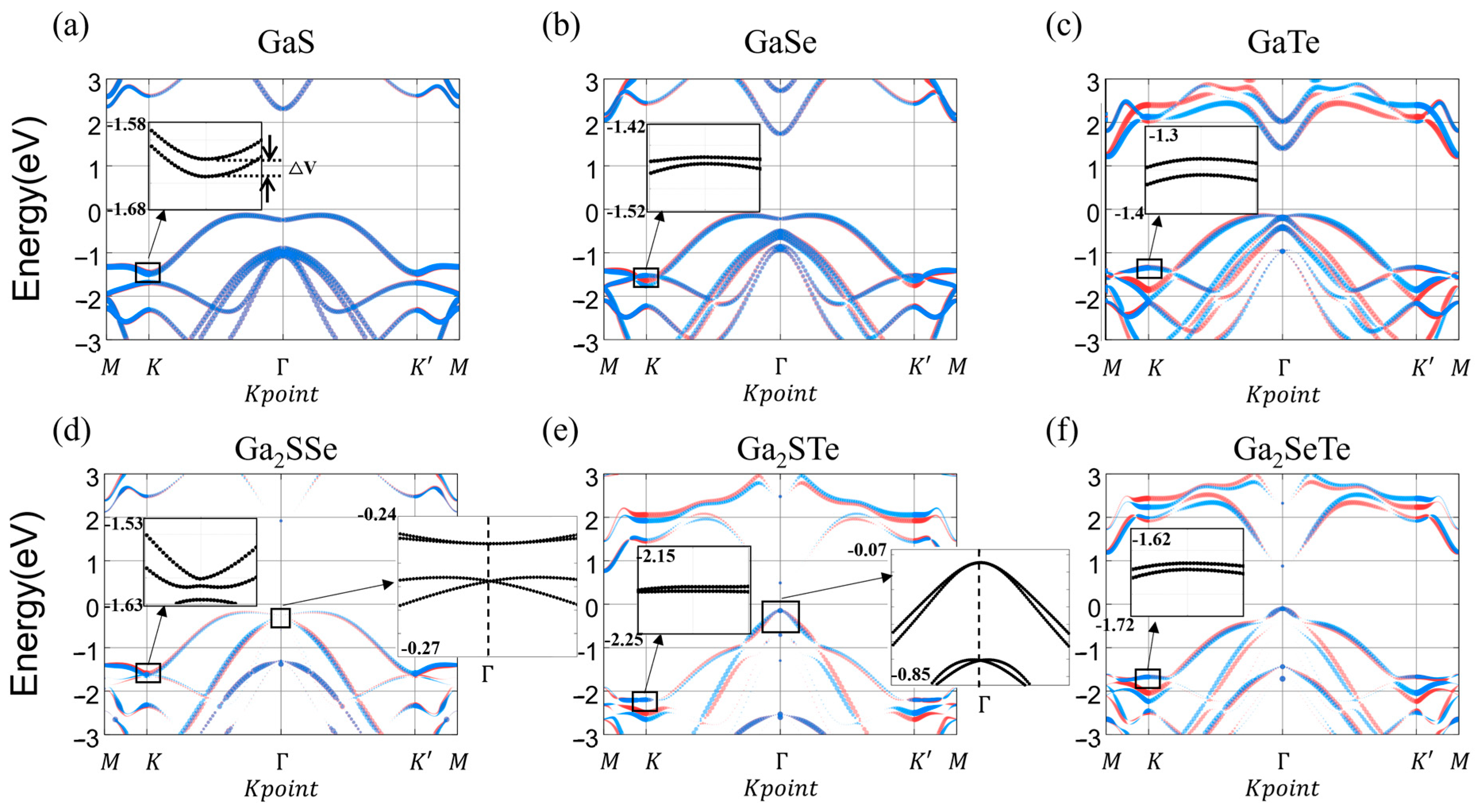
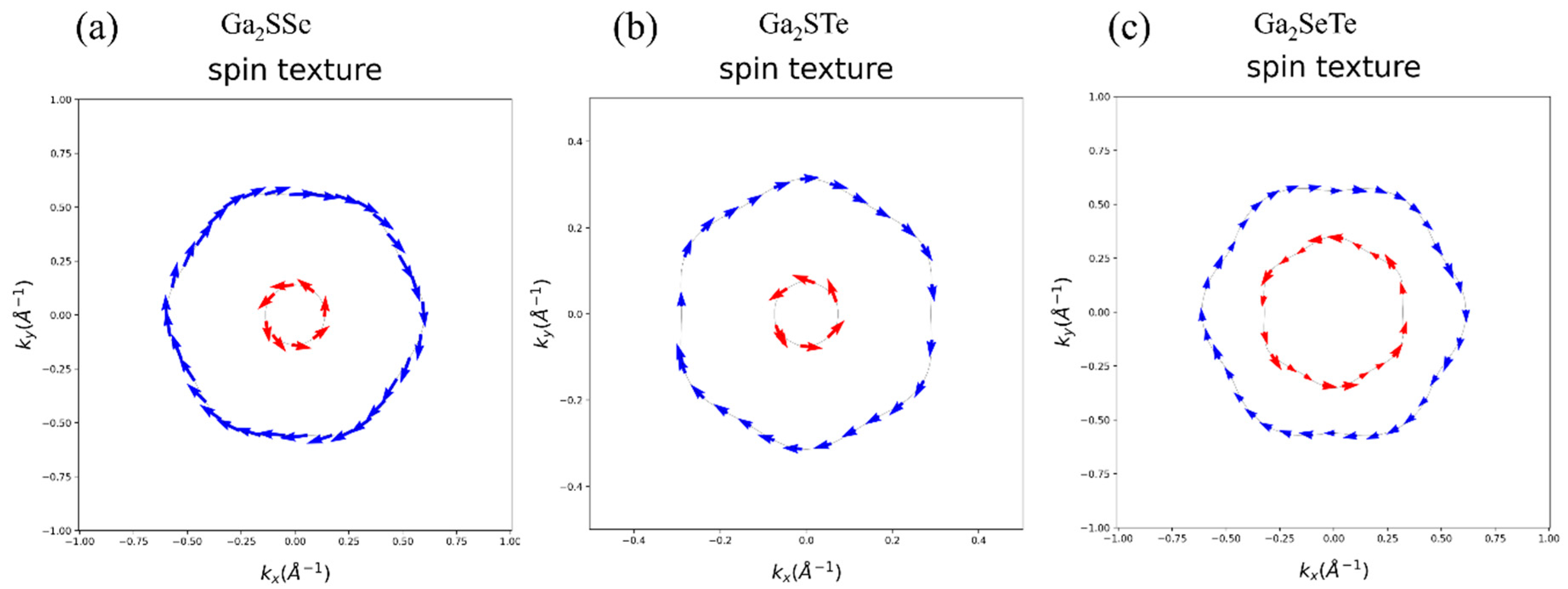

| Band Gap (eV) | Band Gap Type | ||||||||||||
|---|---|---|---|---|---|---|---|---|---|---|---|---|---|
| GaS | 3.62 | 2.45 | 2.36 | 2.36 | 0 | 117.55 | 117.55 | 0 | 0 | – | 2.46 | Indirect | 202 |
| GaSe | 3.80 | 2.45 | 2.49 | 2.49 | 0 | 118.21 | 118.21 | 0 | 0 | – | 1.89 | Indirect | 65 |
| GaTe | 4.12 | 2.45 | 2.70 | 2.70 | 0 | 118.18 | 118.18 | 0 | 0 | – | 1.50 | Indirect | 180 |
| Ga2SSe | 3.71 | 2.45 | 2.39 | 2.47 | 0.08 | 116.07 | 119.63 | 3.56 | 0.25 | 0.016 | 2.16 | Indirect | 97 |
| Ga2STe | 3.88 | 2.45 | 2.44 | 2.63 | 0.19 | 113.27 | 121.73 | 8.46 | 0.61 | 0.043 | 0.64 | Direct | 43 |
| Ga2SeTe | 3.99 | 2.45 | 2.58 | 2.66 | 0.08 | 115.32 | 120.06 | 4.74 | 0.39 | 0.028 | 0.98 | Direct | 65 |
Disclaimer/Publisher’s Note: The statements, opinions and data contained in all publications are solely those of the individual author(s) and contributor(s) and not of MDPI and/or the editor(s). MDPI and/or the editor(s) disclaim responsibility for any injury to people or property resulting from any ideas, methods, instructions or products referred to in the content. |
© 2024 by the authors. Licensee MDPI, Basel, Switzerland. This article is an open access article distributed under the terms and conditions of the Creative Commons Attribution (CC BY) license (https://creativecommons.org/licenses/by/4.0/).
Share and Cite
Kim, J.; Kim, Y.; Sung, D.; Hong, S. Valley-Dependent Electronic Properties of Metal Monochalcogenides GaX and Janus Ga2XY (X, Y = S, Se, and Te). Nanomaterials 2024, 14, 1295. https://doi.org/10.3390/nano14151295
Kim J, Kim Y, Sung D, Hong S. Valley-Dependent Electronic Properties of Metal Monochalcogenides GaX and Janus Ga2XY (X, Y = S, Se, and Te). Nanomaterials. 2024; 14(15):1295. https://doi.org/10.3390/nano14151295
Chicago/Turabian StyleKim, Junghwan, Yunjae Kim, Dongchul Sung, and Suklyun Hong. 2024. "Valley-Dependent Electronic Properties of Metal Monochalcogenides GaX and Janus Ga2XY (X, Y = S, Se, and Te)" Nanomaterials 14, no. 15: 1295. https://doi.org/10.3390/nano14151295






